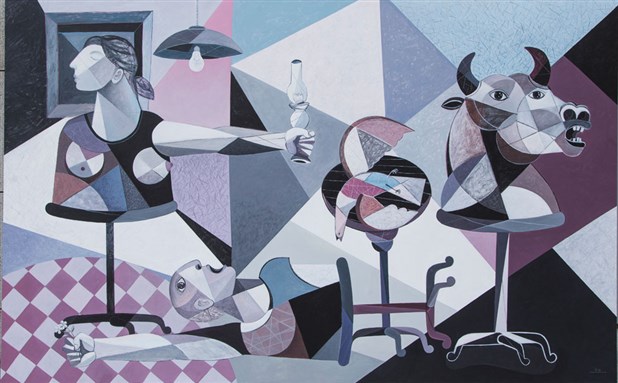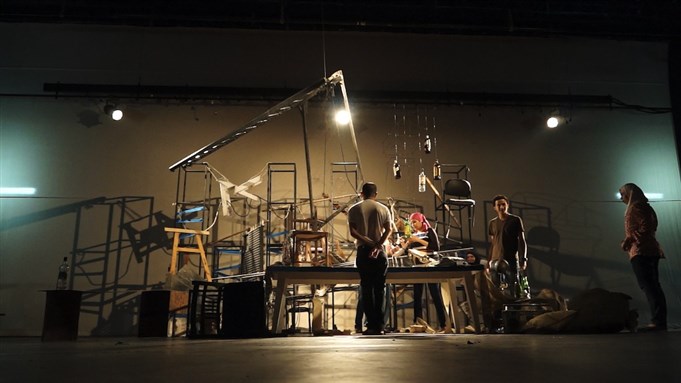For nearly ten years, Oussama Diab has worked through various painting styles, often combining different forms and techniques in a single composition. In neo-expressionist paintings that reimagine Leonardo da Vinci’s Mona Lisa (1503-06), for example, Diab repaints the sixteenth-century portrait using the appropriation methods of Pop art while allowing tactile brushstrokes to operate on a similar level of signification. The Beirut-based Palestinian artist—who was born in Syria and trained at the Faculty of Fine Arts, University of Damascus—describes the amalgamated imagery of his work as autobiographical. Evidence of a pervading sense of dislocation is woven among the historical citations, icons, and references to popular culture that fill his paintings. The political subject matter and overlapping themes of Diab’s canvases detail his own experiences of revolution, war, and migration but are represented in the guise of fragmented symbolism and contrasting stylistic devices, reflecting a simmering dissonance or, at times, an outbreak of chaos.
More broadly, Diab’s postmodern approach reflects the aesthetic crises that led to the development of modern painting and continue in a range of mutations today. In The Body in Pieces: The Fragment as a Metaphor of Modernity, Linda Nochlin observes how certain artists have sought to represent the social, psychic, and political conditions of modern life through disjointed imagery, whether in the form of broken spaces or fractured bodies. Yet after tracing this thread through two centuries of art (beginning in the late 1700s), Nochlin notes that the inverse is also true, arguing that an impulse toward “totalization embodied in the notion of the Gesamtkunstwerk [total work of art]” simultaneously characterized modernism.[1] Nochlin ends her brief survey by discussing artists such as Cindy Sherman, whose work blurs the lines between photography, performance, and cinema as she capsizes the semiotics of popular media. Like many postmodern artists, Sherman turns to historical precedents when seeking to disrupt contemporary norms, exaggerating the basic structure of a given image.
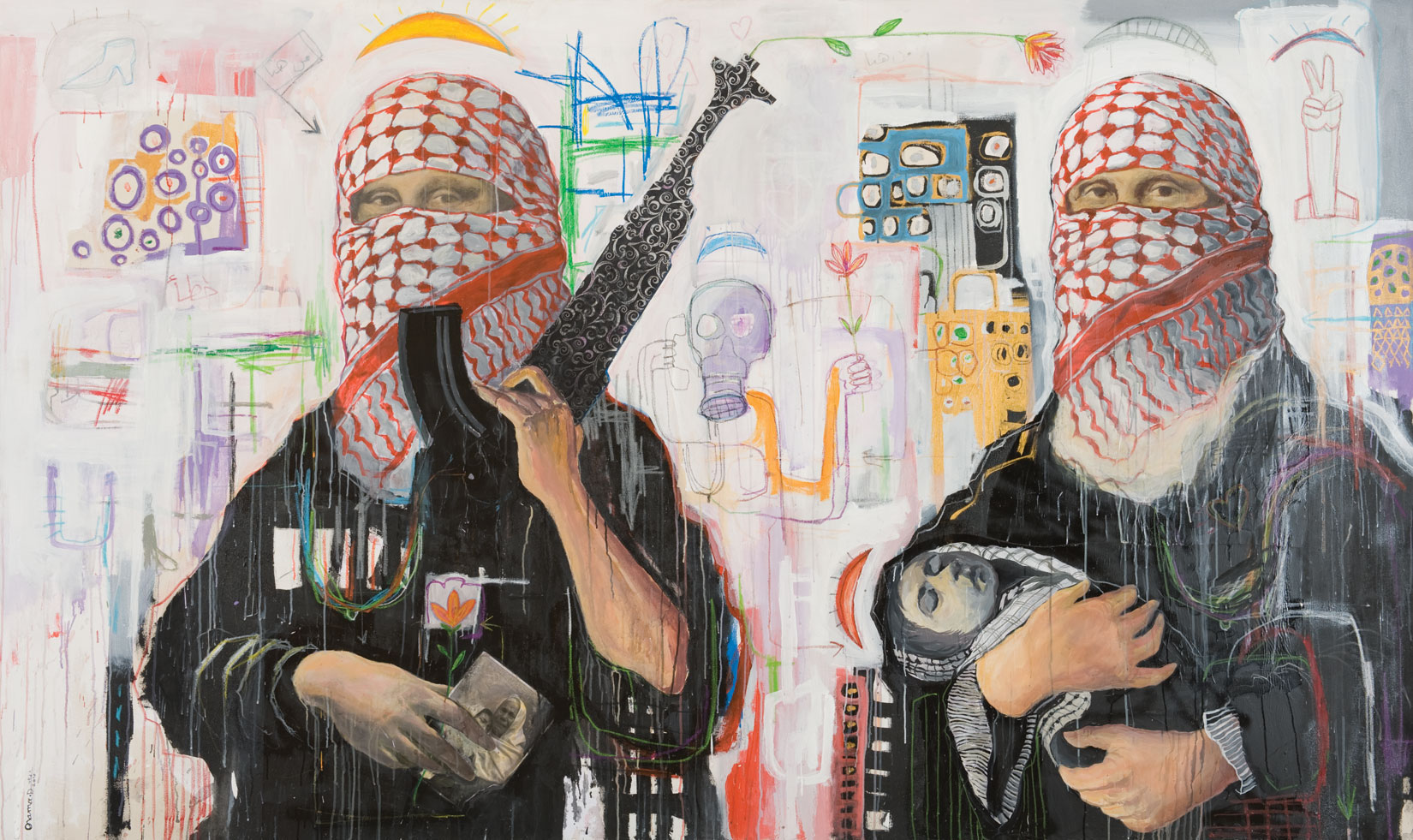 [Oussama Diab, The New Mona Lisa (2010). Image copyright the artist, courtesy of Ayyam Gallery.]
[Oussama Diab, The New Mona Lisa (2010). Image copyright the artist, courtesy of Ayyam Gallery.]
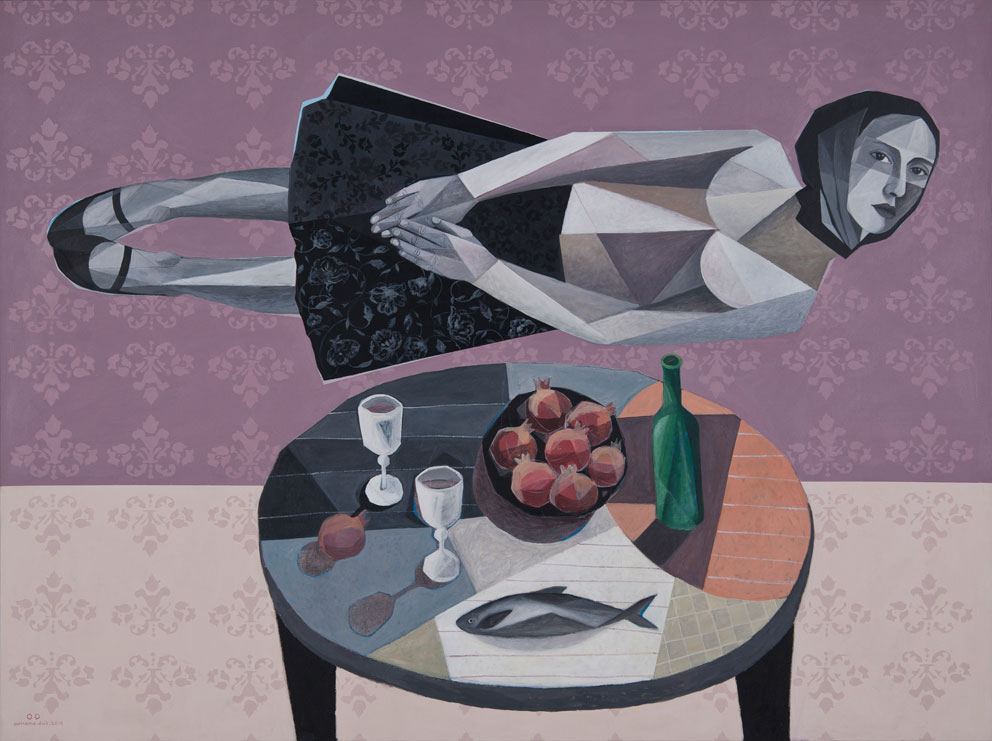 [Oussama Diab, A Lady and Things (2014). Image copyright the artist, courtesy of Ayyam Gallery.]
[Oussama Diab, A Lady and Things (2014). Image copyright the artist, courtesy of Ayyam Gallery.]
Postmodernism in art (and architecture, where the term originated) is often defined as the concurrent sampling of past styles, defying conventions in an attempt to create new forms. Responding to the instability, havoc, and destruction that have engulfed the Arab world in recent years, Diab applies the deconstructed figuration of Cubism to his recurring characters, depicting their splintered bodies amidst the isolation of emptied settings. A couple found in the artist’s previous works resurfaces as the focus of the new paintings. When maimed, the man and woman are rendered as mutilated busts in allegorical still lifes. In other compositions, they are shown restored—situated in the poetics of poised portraits. Diab details the concept of the series in an accompanying artist statement: “I tried to collect the dead bodies of the victims, searching for them on the sidewalks or under the debris, hoping to give them new life.” Both fragmented and whole, the narrative structure of the series and how it is pictorially realized fit Nochlin’s description of art after modernism, specifically among artists who seek to represent the bleakness of reality while offering an alternative.
The popular uprisings that swept across North Africa and parts of the Middle East four years ago are summarized in A Rose for Peace (2015), which shows Diab’s protagonists as a soldier and a civilian separated by the barrels of guns. Placed on matching tables at opposite ends of a room, the two figures bookend the composition. In the space between them, a similar pedestal holding a white bird has been knocked over. The large animal is depicted in pieces, her fragile wings painted as attached parts joined to form new appendages. The dove is shown in several paintings of the series and represents peace, or rather a failed attempt to restore calm. Diab’s female figure extends her right arm to offer a red rose as she turns away screaming—yet the soldier remains fixed on his target. The man’s guns have replaced his physical arms and protrude from his body like projectiles. Painted in profile, a dark silhouette with the ill-omened image of an evil eye appears behind his head. Above the scene is a single light bulb that hangs from an industrial lamp, a fixture that recalls the central light source of Pablo Picasso’s Guernica (1937), which historians identify as representing a bomb. Diab’s adaptation of this detail functions in two ways. At first glance the artist seems to argue that the violent standoff should be illuminated. When viewed with Guernica in mind, the light can also be read as a symbol of perpetual war. Both readings point to the subtext of the painting, which is further emphasized with the angular forms of the composition.
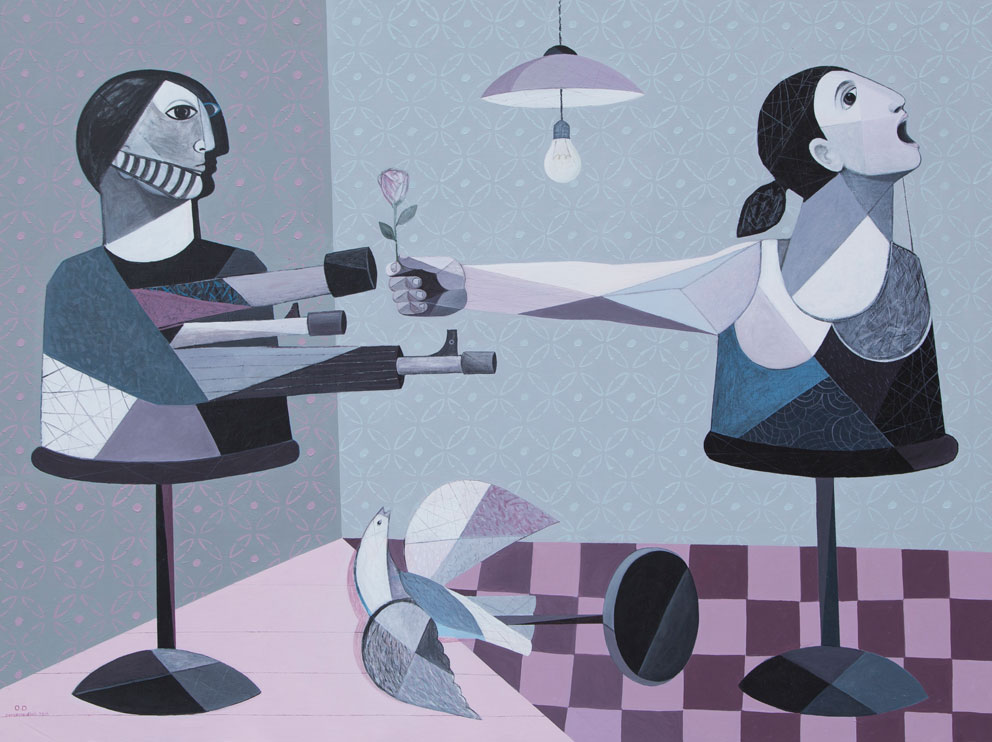 [Oussama Diab, A Rose for Peace, 2015. Image copyright the artist. Courtesy of Ayyam Gallery.]
[Oussama Diab, A Rose for Peace, 2015. Image copyright the artist. Courtesy of Ayyam Gallery.]
Diab’s figures are portrayed with intersecting planes that collide as severed bodies, mirroring the surrounding environment. This treatment of mass and spatial depth is similar to how early cubist painters registered several views of a subject by appealing to “a complex series of mental associations between past and present muscular, tactile or olfactory sensations.”[2] Diab’s paintings allude to continuous time, as the spaces of his scenes reach beyond the limits of the picture plane. The artist achieves this effect by placing his characters against decorative backgrounds that contain neither beginning nor end, or in rooms where only a portion of the scene is described. Realist depictions—such as the flower and hanging lamp in A Rose for Peace—signal objects (or concepts) that remain intact irrespective of how the artist’s narrative develops. Diab uses both methods of representation when painting the soldier’s arms, meticulously drawing the muzzles of their guns while the barrels are rendered as abstracted masses. The resulting forms suggest that although such violence is executed with the mechanisms of power (the state, the army, or factions) inevitably it is an individual who pulls the trigger.
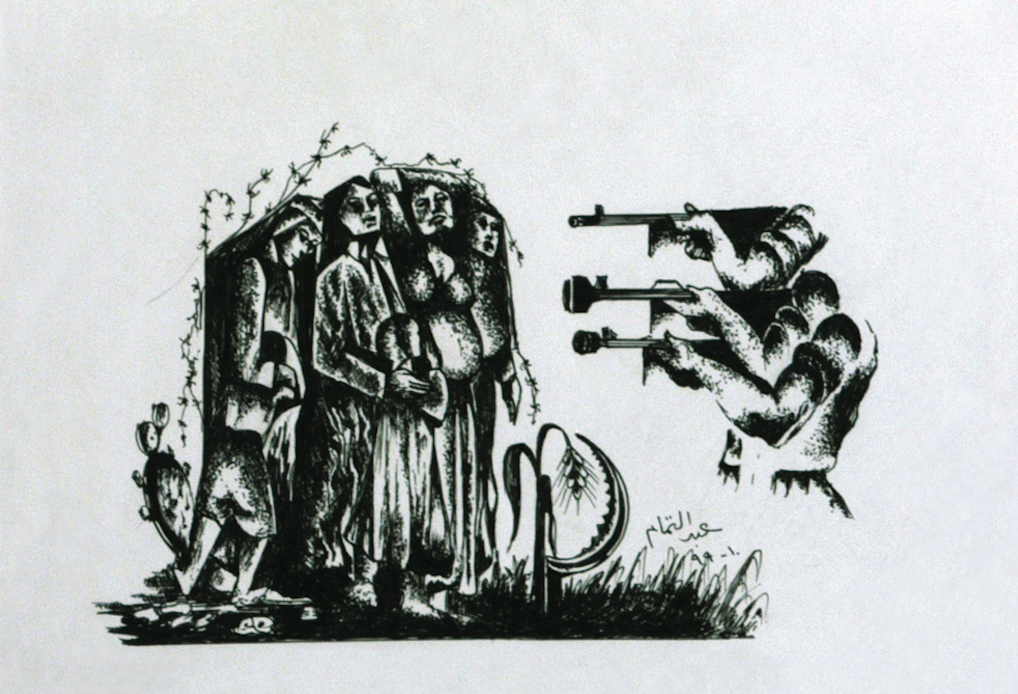 [Abdul Tamam, Harvest Them, 1999. Image copyright the artist, courtesy of Samia Halaby.]
[Abdul Tamam, Harvest Them, 1999. Image copyright the artist, courtesy of Samia Halaby.]
Perhaps unconsciously, Diab seems to have patterned this section of A Rose for Peace after a drawing by Palestinian Liberation artist Abdul Tamam. In the elder painter’s ink on paper work Harvest Them (1999), three Israeli border police are shown as body fragments that point their guns at a crowd of helpless women. The drawing is based on an event that took place in a Palestinian border town during what was later known as the 1956 Kafr Qasem Massacre. The menacing army is intentionally headless, obscuring the identities of its members, and appears as a phantom force foreign to the village scene, which includes expressionist portraits of the martyred victims. The equipped position of the soldiers and the muzzles of their different guns reappear in Diab’s painting, linking politicized aggression across decades. Interestingly, the 1990s drawing resembles Pablo Picasso’s Massacre in Korea (1951), which was produced in response to a mass killing during the American military’s intervention in North Korea. The distinct scene is divided into equal halves with soldiers shown in profile occupying the right side of the painting while a group of women and children are frozen in front of their drawn weapons. It is widely noted that the inspiration for Picasso’s composition is The Third of May (1808), the groundbreaking anti-war painting by Francisco Goya that represents the brutality of French forces during Napoleon’s occupation of Spain. The lineage that stretches from the nineteenth-century work to A Rose for Peace can be summarized as a pictorial approach to social fragmentation. In place of depicting the moments before bloodshed, however, Diab reverses the imbalance of power that is found in the compositions of his predecessors. The civilian woman is placed in the position of the victor (the right side of the painting). Her muscular arm stretches past the muzzle of the first gun, signaling a gesture of hope that overcomes violence. The fallen dove of peace watches the exchange from below.
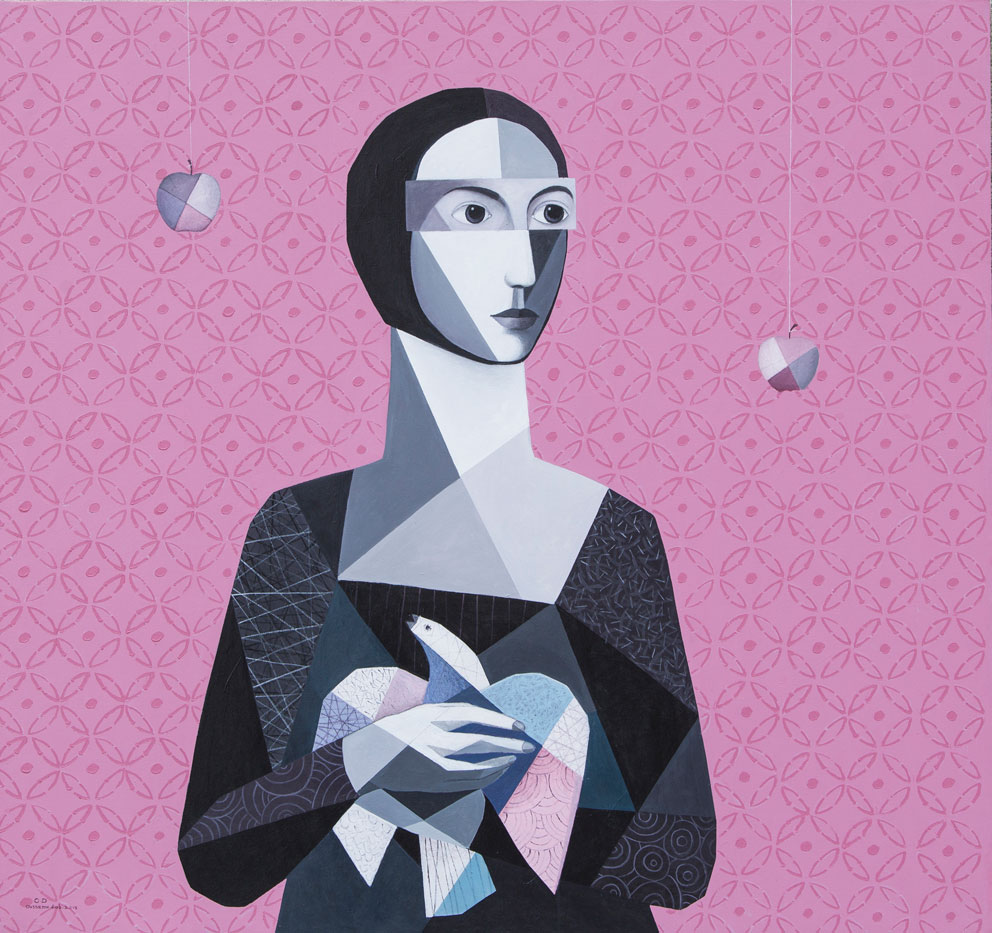 [Oussama Diab, Lady with a Dove, 2015. Image copyright the artist, courtesy of Ayyam Gallery.]
[Oussama Diab, Lady with a Dove, 2015. Image copyright the artist, courtesy of Ayyam Gallery.]
Other historical examples are reconfigured as Diab addresses contemporary issues in his latest series. In Lady with a Dove (2015), the artist inserts his female protagonist into the composition of Leonardo da Vinci’s Lady with an Ermine (1489-90), using the classical format and striking imagery of the Renaissance picture to construct a serene setting for his character. Revived as the elegant subject of da Vinci’s painting, the woman is shown lost in thought as she turns away from the viewer. The triangular shards of her body, the pieces of her past life, form the modest gown that is found in the classical portrait. Her aloof stare is intensified with a rectangular section containing a pair of asymmetrical eyes, creating the semblance of collage while extending Diab’s concept of renewal. The white weasel the Italian adolescent holds (symbolizing purity) is replaced with Diab’s patchwork dove. The woman carries the bird close to her body as though a pet, informing the viewer of the animal’s symbolic importance in A Rose for Peace. Two dangling apples frame Diab’s figure—an evocation of the biblical narrative of Adam and Eve—yet she remains unmoved by temptation, and stares off into the distance. The disregard she displays for the viewer is manifest, as the artist displaces our ability to fully scrutinize his symbolic muse. Representing the martyred, Diab seeks to provide his characters with "the right to judge us," calling attention to the endemic "silence, carelessness, and neglect" that grew as the Arab world imploded.
*Oussama Diab: What Happened Here opens Thursday, 10 September at Ayyam Gallery Beirut.
1. Linda Nochlin, The Body in Pieces: The Fragment as a Metaphor of Modernity. (London: Thames & Hudson, 1994).
2. Mark Antiff and Patricia Leighten, Cubism and Culture. (London: Thames & Hudson, 2001).
